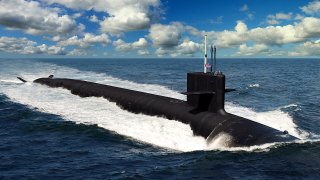The U.S. Navy's Columbia-Class Submarine Nightmare Is Just Getting Started
The U.S. Navy is facing significant challenges with the construction of its latest submarines, including the Columbia-class ships and Block V variants of the Virginia class, due to supplier issues, delays, and spiraling costs.
Summary: The U.S. Navy is facing significant challenges with the construction of its latest submarines, including the Columbia-class ships and Block V variants of the Virginia class, due to supplier issues, delays, and spiraling costs. The first Columbia-class submarine's delivery may be postponed by a year to FY 2028, jeopardizing U.S. nuclear deterrence capabilities as these submarines are vital, carrying over half of the nation’s operational nuclear arsenal. Delays are attributed to production issues, such as those at HII’s Newport News Shipbuilding in Virginia and with Northrop Grumman's steam turbines. This setback occurs amid escalating tensions between Washington and Beijing, underscoring the urgency of maintaining a robust and timely defense capability.
Columbia-Class Problems
Construction of the U.S. Navy’s latest submarines is flagging amid delays, production issues, and exorbitant costs. Supplier issues are impacting Columbia-class ships and the Block V variants of the Virginia class.
According to reports, the lead ship in the Columbia class might be delayed by a year, risking a gap in U.S. nuclear deterrence. America’s submarine fleet carries over half of the nation’s operational nuclear deterrent arsenal, making these vessels critical for national security.
According to the U.S. Naval Institute, the first Columbia vessel, the Navy’s highest-priority acquisition program, could arrive in Fiscal Year 2028, a year behind its planned FY 2027 delivery. The greatest delay affects the bow module currently being built at HII’s Newport News Shipbuilding in Virginia. Other delays reportedly stem from the steam turbines that manufacturer Northrop Grumman is tasked with developing.
The Navy recently released a rare public accounting that outlines these issues in detail. The service foresees a cumulative delay of more than a decade. As tensions continue to heat up between Washington and Beijing and a future kinetic conflict in the South China Sea becomes more likely, this report is concerning.
The commander of Naval Sea Systems Command commented on the report, noting that, “The supply chain is different now. We need to think longer term when it comes to buying materials further ahead than we’ve traditionally done in the past. And that’s just the world we live in today. So there [are] some differences that we found that we need to dial into how we do this work going forward.”
Introducing the Columbia-Class Submarines
Regardless of what happens with the Columbia class, the Navy’s Ohio-class submarines will be retired at a rate of one per year beginning in 2028. Only two Columbia-class ships – the USS District of Columbia (SSBN-826), and the USS Wisconsin (SSBN-827) – have been ordered so far. They will be followed by an additional 10 submarines. Electric Boat is designing the new class along with Newport News Shipbuilding. While the former remains the primary contractor on the project, the latter is responsible for detail planning, engineering analyses, development of components, and technical services.
Specs & Capabilities
The new ballistic missile submarines will sport X-shaped stern control surfaces and sail-mounted dive planes, according to Naval Technology. Each ship will be equipped with 16 missile tubes for launching 16 Trident II D5 submarine-launched ballistic missiles.
While details surrounding the exact specs and capabilities of the Columbia vessels remain largely under wraps, we do know that an upgraded D5LE2 ballistic missile will be incorporated from the ninth boat onward. This weapon is the product of a joint venture between the U.S. and the United Kingdom. Engineers have touted the Trident II as the most sophisticated ballistic missile in the world. This weapon can carry multiple independently targeted re-entry vehicles and is fitted with a celestially aided inertial navigation system.
The Columbia class is on track to become one of the costliest Pentagon programs to ever be developed. The total lifecycle price for the entire class is estimated at nearly $348 billion, which includes the projected costs to develop and purchase the 12 submarines and maintain them through the early 2040s.
The Navy’s Virginia-class Block V submarine variants will also fail to meet initial production timeline trajectories. According to the service’s 45-day review, these vessels are running roughly three years behind schedule.
About the Author: Maya Carlin
Maya Carlin, National Security Writer with The National Interest, is an analyst with the Center for Security Policy and a former Anna Sobol Levy Fellow at IDC Herzliya in Israel. She has by-lines in many publications, including The National Interest, Jerusalem Post, and Times of Israel. You can follow her on Twitter: @MayaCarlin.


